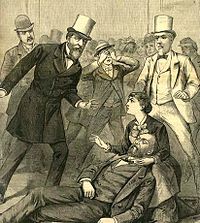On September 19, 1881, President James A. Garfield succumbs to wounds inflicted by an assassin 80 days earlier. Garfield's assassin was an attorney and political office-seeker named Charles Guiteau. Guiteau was a relative stranger to the president and his administration in an era when federal positions were doled out on a "who you know" basis. When his requests for an appointment were ignored, a furious Guiteau stalked the president, vowing revenge.
On the morning of July 2, 1881, Garfield headed for the Baltimore and Potomac Railroad station on his way to a short vacation. As he walked through the station toward the waiting train, Guiteau stepped behind the president and fired two shots. The first bullet grazed Garfield's arm; the second lodged below his pancreas. Doctors made several unsuccessful attempts to remove the bullet while Garfield lay in his White House bedroom, awake and in pain. Alexander Graham Bell, who was one of Garfield's physicians, tried to use an early version of a metal detector to find the second bullet, but failed. Historical accounts vary as to the exact cause of Garfield's death. Some believe that experimental medical treatments may have hastened his demise. Others insist Garfield died from an already advanced case of heart disease. By early September, Garfield, who was recuperating at a seaside retreat in New Jersey, appeared to be recovering. He died on September 19th. Autopsy reports at the time said that pressure from his internal wound had created an aneurism, which was the likely cause of death. Guiteau was deemed sane by a jury, convicted of murder and hanged on June 30, 1882.
Michael Thomas Barry is a columnist for crimemagazine.com and the author of Murder & Mayhem 52 Crimes that Shocked Early California1849-1949. The book can be purchased from Amazon through the following link:



No comments:
Post a Comment